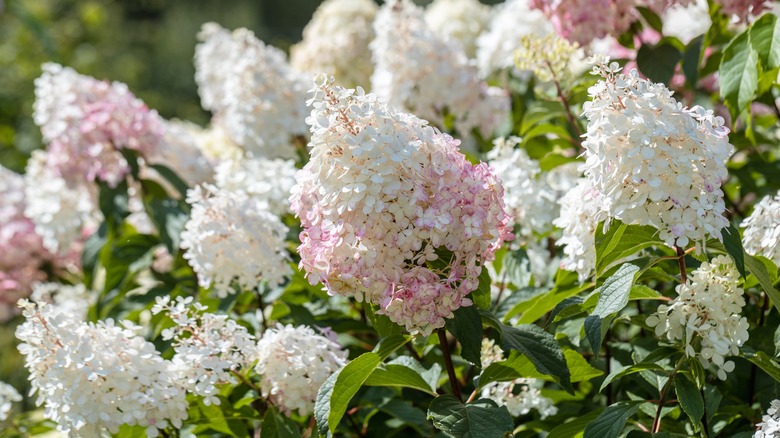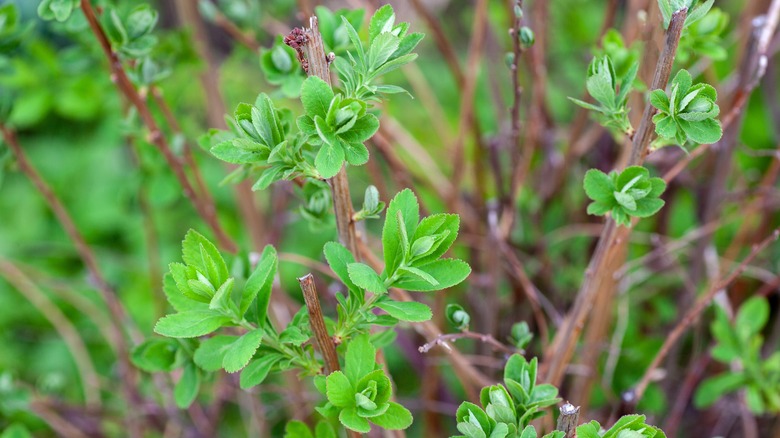Keep Limelight Hydrangea Bushes From Flopping Over With This Helpful Gardening Tip
Limelight hydrangeas (Hydrangea paniculata) are robust, bushy shrubs that can grow up to 8 feet tall. Native to eastern and southern China and Japan, this flowering perennial blooms in summer through fall with large, cone-shaped flowers that are popular in cut flower and dried floral arrangements. Although this cultivar has sturdier stems than some other hydrangea varieties, long, leggy, or weakened stems can collapse under the weight of the flower heads. Hard pruning your limelight hydrangea before the growing season begins will encourage strong, bushy growth that supports the showy blooms.
The flowers transition from pale green to white and through to soft pink as they mature – in warmer, southern climates the flowers may only stay pink for a short time. Limelight hydrangeas grow best in evenly moist, rich, loamy soil that is well-draining. They are winter hardy and tolerant of more sun than other Hydrangea varieties but prefer a spot that receives morning sun and afternoon shade. Once established, they are considered relatively low maintenance. Knowing how to take care of hydrangeas will make sure this versatile, ornamental plant continues looking its best.
How to prune limelight hydrangea bushes
Pruning limelight hydrangea bushes is essential for encouraging robust growth and stimulating vigorous, sturdy stems that are less likely to collapse. Limelight hydrangeas can be pruned from fall to early spring. However, to fully enjoy their fall blooming period, it is best to wait until the late winter or early spring, making sure to prune before new growth resumes. This cultivar can be pruned aggressively — in fact, pruning back to just a framework of branches each year will encourage prolific flowering and strong, upright branches.
Start by removing any dead or weakened wood, cutting back to the base of the plant to promote new shoots. Prune back healthy stems, particularly those that are leggy or floppy, to just a pair of buds. Make the cut about ¼ inch above the bud — cutting too close can inhibit new growth whereas too far away will cause the remaining wood to die back. While pruning your plants, always use clean, sharp pruning tools to prevent disease and promote quicker healing.
Why does pruning keep limelight hydrangeas from flopping?
Unlike other Hydrangea varieties, limelight hydrangeas bloom on new growth rather than old wood. This means that removing last season's stems does not inhibit the next season's bloom but rather stimulates sturdy growth and abundant flowering. If limelight hydrangeas are not pruned regularly, the old stems can become leggy and eventually collapse.
Pruning encourages limelight hydrangeas to become bushier. In plants, apical buds are found at the tip of each stem, and they have a special role in controlling the growth of the plant upward. However, when you prune a plant and remove the apical bud, the lateral buds get a chance to spring into action — they start producing new branches and leaves. For limelight hydrangeas, this leads to the plant becoming fuller and more robust, producing stronger stems that are able to support the large flowers. For more compact Hydrangea paniculata cultivars, consider choosing limelight prime, Bobo, or little lime. These smaller varieties still require annual pruning but have shorter, sturdier stems and may be more suited to growing in smaller gardens.

